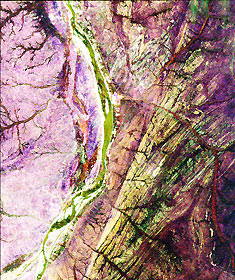
Save this image free of charge
in 800 pixels for layout use
(right click, Save as...)
|
|
Ref : V01897
Theme :
Looking at Earth - Faults (69 images)
Title : Space Radar Image of Sudan Collision Zone
Caption :
This is a radar image of a region in northern Sudan called the Keraf Suture that reveals newly discovered geologic features buried beneath layers of sand. This discovery is being used to guide field studies of the region and has opened up new perspectives on old problems, such as what controls the course of the Nile, a question that has perplexed geologists for centuries. The Nile is the yellowish/green line that runs from the top to the bottom of the image. A small town, Abu Dis, can be seen as the bright, white area on the east (right) bank of the Nile (about a third of the way down from the top) at the mouth of a dry stream valley or 'wadi' that drains into the river. Wadis flowing into the Nile from both east and west stand out as dark, reddish branch-like drainage patterns. The bright pink area on the west (left) side of the Nile is a region where rocks are exposed, but the area east (right) of the Nile is obscured by layers of sand, a few inches to several feet thick. Virtually everything visible on the right side of this radar image is invisible when standing on the ground or when viewing photographs or satellite images such as the United States' Landsat or the French SPOT satellite. A sharp, straight fault cuts diagonally across the image, to the right of the Nile river. The area between the fault and the Nile is part of the collision zone where the ancient continents of East and West Gondwana crashed into each other to form the supercontinent Greater Gondwana more than 600 million years ago. On this image, the Nile approaches but never crosses the fault, indicating that this fault seems to be controlling the course of the Nile in this part of Sudan. The image is centered at 19.5 degrees north latitude, 33.35 degrees east longitude, and shows an area approximately 18 km by 20 km (10 miles by 12 miles). The colors in the image are assigned to different frequencies and polarizations of the radar as follows: Red is L-band, vertically transmitted and vertically received; green is L-band, horizontally transmitted and vertically received; and blue is C-band, horizontally transmitted and vertically received.This image was acquired by the Spaceborne Imaging Radar-C/X-band Synthetic Aperture Radar (SIR-C/X-SAR) when it flew aboard the space shuttle Endeavour in April 1994. SIR-C/X-SAR, a joint mission of the German, Italian and United States space agencies, is part of NASA's Mission to Planet Earth.
|
|

